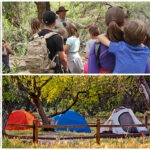Nursing my two children.Mireya Gonzalez, Los Angeles, California
Restoring indigenous practices is a powerful act of cultural reclamation, and for me, breastfeeding is deeply intertwined with my Family Lineage. As I nourish my children, Hoshea, 22 months, and Hadassah, six years old, in our community’s milpa (cornfields) at the Zapotepec Indigenous Cultural Research Center in Los Angeles, I feel an undeniable connection to my Nahuatl and P’repecha ancestors. Witnessing my children thrive on my breast milk alongside the corn, beans, and amaranth we planted during our spring ceremony reinforces the belief that they are seeds of our lineage, my milk is a sacred offering, and my body, like Tonantzin (Mother Earth), provides life. This is more than just breastfeeding; it’s about nurturing vitality and a cultural identity rooted in our heritage. It’s about raising my children as my grandmothers did, with breastfeeding, agriculture, and sacred first foods.
My grandmother, Pompeya, a P’repecha woman from Michoacán, Mexico, instilled in me the importance of our land. I cherish memories of playing in her milpas and rooms filled with corn kernels ready for masa. Her ability to reclaim her home after migrating to the United States was a testament to the community that sustained her land during her absence, and it gifted me with invaluable childhood memories of Michoacán. However, migration to the U.S. profoundly impacted our family lineage. Poverty led my grandfather to the Bracero program, resulting in him abandoning my grandmother and her eight children. Forced to work, my grandmother had to stop breastfeeding. She eventually brought her children, including my mother, to Los Angeles, a journey marked by separation, deportation, and loss.
Left: Braceros arriving to the U.S. and working in the fields. Right: My grandmother as a single mother raising eight children.
The hardships of poverty and migration disrupted my grandmother’s way of life, and consequently, my mother and her younger siblings were not breastfed like their older siblings. When my mother gave birth to me and my siblings in a Los Angeles hospital, breastfeeding was not an option. Lacking knowledge, support from hospital staff, and English proficiency, she was unable to continue the tradition. My grandmother’s forced cessation of breastfeeding inadvertently broke the chain of intergenerational knowledge, leaving my mother vulnerable to Western hospital practices. None of my aunts in the U.S. breastfed either, citing lack of knowledge and hospital support. Assimilation further eroded indigenous traditions, including infant feeding practices. Breasts became sexualized, perceived as objects of male pleasure rather than sources of nourishment. This shift led my mother and aunts to seek breast implant surgery in Mexico, influenced by Western beauty standards portrayed in Spanish-language media. Traditionally, puberty was a time for learning about our bodies, breastfeeding, and milk sharing. But this knowledge was not passed down to my generation.
When my older sister turned eighteen, my mother encouraged breast implants, reflecting the profound impact of Western ideals on our family’s perception of womanhood and our bodies. This distorted view continued to the next generation; my older cousins did not breastfeed, echoing my mother and aunts’ reasons – lack of knowledge and support – but adding a new dimension: the belief that breasts were primarily for sexual attraction.
I am the youngest grandchild and the first in my family in two generations to breastfeed, consciously reclaiming this ancestral tradition and embracing my indigenous identity. My six-year-old daughter, still breastfeeding and nurturing her dolls in the same way, will grow up with breastfeeding as a normalized part of her life. She has already expressed her intention to breastfeed if she becomes a mother, ensuring the continuation of this restored family lineage practice. For me, true breastfeeding normalization and reclamation must extend to future generations.
Left: Proudly tandem nursing my children. Right: My daughter tandem nursing her dolls.
Breastfeeding my children publicly in our community is an act of pride in our Indigenous identity. Restoring breastfeeding, alongside our rich culture – food, ceremony, and language – is an act of cultural survival and historical resilience. I cherish conversations with my mother about her childhood memories of breastfeeding and milk sharing in Michoacán. I also teach her about the significance of breastfeeding, and she proudly watches me nurse her grandchildren, often telling her sisters about their health benefits. We are slowly weaving breastfeeding back into our family lineage, generation by generation.
Reclaiming my Indigenous identity is a lifelong journey, and breastfeeding is a cornerstone of this process. Especially during a pandemic, breastfeeding and our community’s research center are vital for addressing the loss of identity caused by migration, acculturation, poverty, and food insecurity. Breastfeeding embodies self-sustainability and serves as a sacred first food, representing Indigenous food sovereignty, dignity, and resilience. My commitment extends beyond the first six months; I am dedicated to reclaiming breastfeeding throughout my parenting journey and supporting other Indigenous people in the U.S. who have experienced similar losses. I strive to embody the generosity of my ancestors and Tonantzin, offering nourishment and vitality, allowing my children to self-wean when they are ready. Native Breastfeeding Week is a time to celebrate my story, my family lineage, my Indigenous perspective on breastfeeding, Mother Earth, and all Native nations worldwide. Happy Native Breastfeeding Week!
Left: Me holding my hand expressed milk as an offering. Middle: Me and my grandmother before I became a mother, and before she passed away. She would be proud of how our I rewrote our family’s lineage breastfeeding story. Right: My family’s restored milpa in 2019 in Michoacán Mexico.
References
Please send your story ideas to Amy at [email protected].
 Red heartSupport Breastfeeding Families–Today, Tomorrow, Always
Red heartSupport Breastfeeding Families–Today, Tomorrow, Always
Please consider donating to La Leche League USA. Donations of any amount are gratefully accepted. Thank you!
Category: National/International Events/Projects
← Seven Ways To Celebrate World Breastfeeding Week
National Breastfeeding Month: Spotlight On The New Jersey Breastfeeding Coalition →

